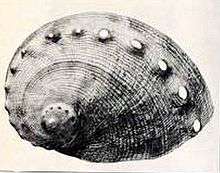Haliotis dalli
Haliotis dalli, common name the Galápagos abalone, is a species of sea snail, a marine gastropod mollusk in the family Haliotidae, the abalones.[1]
| Haliotis dalli | |
|---|---|
 | |
| Original image of Haliotis dalli | |
| Scientific classification | |
| Kingdom: | Animalia |
| Phylum: | Mollusca |
| Class: | Gastropoda |
| Clade: | Vetigastropoda |
| Family: | Haliotidae |
| Genus: | Haliotis |
| Species: | H. dalli |
| Binomial name | |
| Haliotis dalli Henderson J.B., 1915 | |
| Synonyms | |
|
Haliotis (Padollus) dalli Henderson J.B., 1915 | |
It has been confused in the past with Haliotis pourtalesii Dall, 1881, that occurs off Florida. This was due to the destruction of the holotype of Haliotis pourtalesii in the Great Chicago Fire of 1871.
- Subspecies
- Haliotis dalli dalli Henderson, 1915
- Haliotis dalli roberti McLean, 1970 (synonym: Haliotis roberti McLean, 1970)
Description
The description given by W.H. Dall in 1889 of Haliotis pourtalesii matches exactly the description used in 1915 by J.B. Henderson in describing Haliotis dalli, with W.H. Dall agreeing.[2]
"The small shell has a pale brick-red color, with white dots on some of the spirals. The shell is rather elevated, with about two and a half whorls. The apex is small and prominent. It contains about 25 holes of which five remain open. The margins of these are rather prominent. Outside the row of holes the usual sulcus is strongly marked. About midway from the suture to the lines of holes is a raised rib, rather obscure, but differing in different individuals and corresponding to an internal sulcus. Between the central ridges and the suture there are no undulations or transverse ridges of consequence. The sculpture consists of well marked, rather flattish, spiral, close-set threads, sometimes with a single finer intercalary thread, overlaid by smaller rather compressed transverse ridges, in harmony with the incremental lines. On top of the spirals the ridges bulge like the threads of worsted on canvas embroidery. The spire is situated well forward and with subvertical sides. The interior surface is pearly. The coil of the spire is rather close and the margin of the columella is flattened."[3]
This species differs from most other Haliotis species by having a very narrow lateral tooth in the radula and having concentric rings on the cephalic tentacles. It shares these characteristics only with Haliotis roberti (which has become the subspecies Haliotis dalli roberti, (McLean, 1970)) and Haliotis pourtalesii and the subspecies Haliotis pourtalesii aurantium (Simone, 1998)[4]
Distribution
This species occurs in the Pacific Ocean off the Galapagos Islands and Western Colombia.
References
- Haliotis dalli Henderson, 1915. Retrieved through: World Register of Marine Species on 9 April 2010.
- J.B. Henderson, Rediscovery of Pourtales' Haliotis, Proceedings of the United States National Museum v. 48 1915 pp. 660–661
- H.A. Pilsbry (1890) Manual of Conchology XII; Academy of Natural Sciences, Philadelphia, 1890 (described as Haliotis pourtalesii)
- Geiger, D. L. 1998. Recent genera and species of the family Haliotidae (Gastropoda: Vetigastropoda). The Nautilus 111: 85–116.
- Geiger D.L. & Owen B. (2012) Abalone: Worldwide Haliotidae. Hackenheim: Conchbooks. viii + 361 pp.
External links
- "Haliotis (Padollus) dalli". Gastropods.com. Retrieved 16 January 2019.